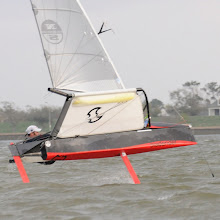I always enjoy working with Sparmakers, it was one of my favorite parts of the AC design and luckily a very large part of North Sails Design Services work.
One of the things I find fascinating with mast analysis is that simulations can be checked with hand calculations pretty easily. This is something which is not possible with sail design, maybe this is one of the reasons that sail design still is very much a mix of art and science where mastmaking, while still a very creative process, is a pure engineering exercise.
Working with Southern Spars is always great, they have more engineers in-house than most of the other mastmakers combined (I don't think that is an exaggeration)! So there are always new tricks to learn. As everyone will soon know (Or should have figured out by reading the sail selection chart) the new Southern Rigs are a little stiffer than most other moth rigs.
Right now we are developing the V6 and V10 designs. North Sails Cape Town has built a lot of test sails so far for the Moth, so it was important to try to model the Southern Rig carefully to get the luff curve perfect in order to keep our prices affordable. Therefore a lot of homework was done to hopefully get the V6 and V10 designs perfect on the 1st couple prototypes.
 The above graph is the measured deflection and predicted deflection of the CST 351 tubes. This test was required to calculate the EI's (Stiffness and Stiffness distribution) of the most common skinny mast.
The above graph is the measured deflection and predicted deflection of the CST 351 tubes. This test was required to calculate the EI's (Stiffness and Stiffness distribution) of the most common skinny mast.Two Southern Spars tubes are being offered, the Standard P1 tube and the Phat Boy tube for sailors above 85kg or so. The theory is that larger sailors apply more force through greater Righting Moment and therefore force masts to bend more than a smaller sailor.
Therefore it is possible to design two different stiffness masts which will bend the same if a more powerful sailor is using the stiffer mast. This is critical for North Sails because by understanding this relationship we can make a mainsail design which should work for both rigs as long as sailors choose a rig which is appropriate for their size and fitness. This also gives larger sailors a more level playing field as they will not loose as much power through added mastbend than the average mothie.
 The chart above shows the total mast deflection of a CST 351, Southern Spars P1 and Southern Spars Phat Boy rigs. Also shown is the Southern Phat boy rig with an additional 10% more downhaul which is a good measure of the added mastbend the stronger sailors can exert on the mast (Mostly through side bend) than the average mothie.
The chart above shows the total mast deflection of a CST 351, Southern Spars P1 and Southern Spars Phat Boy rigs. Also shown is the Southern Phat boy rig with an additional 10% more downhaul which is a good measure of the added mastbend the stronger sailors can exert on the mast (Mostly through side bend) than the average mothie. 




1 comment:
Its a bit unfair to compare a 2 year old CST M351 spar with this years Southern Spar. Last year Clive told me the 351 was designed to match the std Burville X8 mast bend, it was quickly superseded by sucessivley stiffer masts.
The current CST listed on Carbon Fibre Express is the 353 which is considerably stiffer than the M351. I have a M354 which is stiffer still and I know of a M355 in use as well.
Talking to Brownie at the Aust nationals I think the Southern masts were comparable to the 354.
Ironically I also have an old Thorpe 7 ply which although bigger diameter than the new masts is almost exactly the same weight and stiffness of the new 354.
Post a Comment